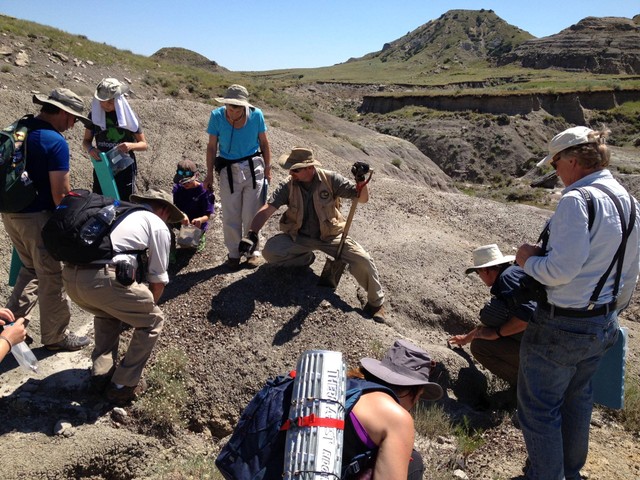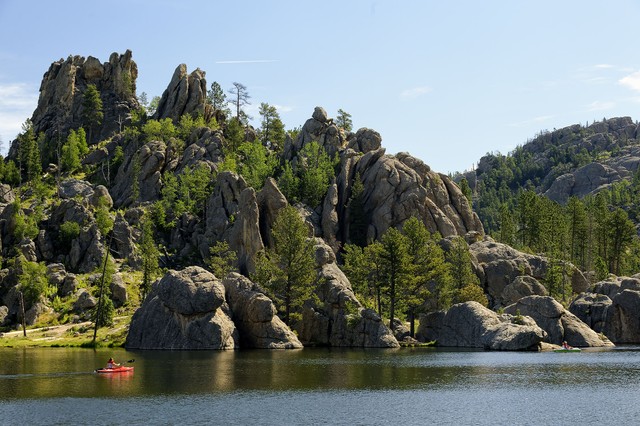When Big John, the world’s largest ever found Triceratops fossil, sold at auction to a private buyer in October, the transaction put a spotlight on the little-known world of commercial paleontology. Some in the academic community voiced concern that private sales would drive up prices for scientifically significant fossils, while others praised commercial efforts as essential to uncovering important specimens in the time-sensitive race against weathering and erosion.
National Geographic wrote a lengthy piece about the debate that highlights the arguments of both sides.
Controversy aside, the buzz around Big John also introduced many people to paleo tourism, which allows everyday travelers to participate in dinosaur digs. To better understand how mindful travelers can participate and what to expect, we talked to Walter Stein, President of PaleoAdventures, the company that uncovered Big John. Here’s what we learned.
What Is Paleo Tourism?
Paleo tourism allows travelers to dig alongside the experts in a structured, controlled environment on private land. PaleoAdventures offers guided trips to the Hell Creek Formation in South Dakota. Designed for educators, dinosaur enthusiasts, and aspiring paleontologists age 12 or older, the trips give participants a chance to learn about paleontology while uncovering fossils on their own. PaleoAdventures sets aside scientifically significant fossils for museums and academia, but participants can often keep common fossils. Interest in paleo tourism has risen across the world since COVID-19, with tourist-friendly trips taking place as far away as Australia. (Read about more COVID-19 travel trends.)
What Can Guests Expect?
Paleo tourism can lead to once-in-a-lifetime discoveries, but it also requires patience. “Digging dinosaurs is a lot of fun and guests are fully immersed in the subject, but it’s not for everyone,” Stein explained in an email. “We start the day at 8 a.m. and usually do not get back to town until almost 8 p.m. It’s a long day, kneeling in the dirt, slowly and delicately chipping away at the rock under a blazing sun.”
In the quarry where digs take place temperatures often climb above 100 degrees. Despite the sun and blowing winds, guests need to remain focused and patient to be successful, Stein explains.
“In paleontology, patience and determination is the name of the game. Those who bounce around a lot generally do not find too much. Those who listen well and focus are often rewarded with a nice discovery. Something no other human has laid eyes on. Something the sun hasn’t hit in over 66 million years.”
How Does Paleo Tourism Support Science?
Commercial and academic paleontologists have a long history of working together. In fact, some of the world’s most celebrated paleontologists worked commercially. Mary Anning, the world’s first female paleontologist, is one example.
“Anning sold fossils for a living and earned a lot of respect from her male academic counterparts,” Stein notes. “Without her work many European museums would have very few Jurassic age marine fossils for display.”
Today, commercial paleontologists help the scientific community gain access to specimens on private lands that would otherwise be off-limits. Since erosion is a constant threat to fossils, the assistance of commercial groups helps to uncover a greater variety of specimens.
“One of the best examples I can give is with the ultimate carnivore, Tyrannosaurus rex,” Stein says. “From 1902 to 1990 there were only 13 known skeletons of T. Rex found. Since the explosion of commercial groups in the 1990s and beyond, we now have more than 72 known skeletons.”
Academics who argue against commercial activity worry that rare specimens may be lost to private efforts, particularly in areas like Montana where fossils are more likely to be scientifically significant. Most paleo tourism in the United States takes place in the Hell Creek Formation of South Dakota, where even large finds like Big John warrant little interest from researchers.
As Denver Fowler, curator of the Badlands Dinosaur Museum at North Dakota’s Dickinson Museum Center, told National Geographic of the Triceratops, “it’s very limited in how useful it would be for science.”
Understanding Fossil Quality
At the heart of the fossil debate is what constitutes a scientifically significant find. “Fossils are not equal by any stretch of the imagination,” Stein explains. “Some are way more important than others.” Paleontologists use a combination of factors to determine their value to research. These include size, condition, quality, completeness, mineralogy and rarity. Big John, for example, had size and completeness, but it wasn’t rare enough to interest researchers.
PaleoAdventures divides fossils into one of three categories: common, commercial, or scientifically significant. Common fossils refer to bone fragments, turtle shell fragments, alligator teeth, Triceratops and Edmontosaurus teeth, and plant fossils. Museums already have thousands of similar specimens.
Commercial-grade fossils refer to plentiful fossils that have commercial value, but little research value. Examples include T. Rex teeth or Edmontosaurus bones not connected to a skeleton. Private collectors value these specimens, but museums typically have enough. In the case of PaleoAdventures, guests can choose to have these pieces appraised and may buy them for an extra fee. Landowners receive a percentage of the sale.
The final category refers to rare finds that museums actively seek. Examples include fossils from juveniles, fossils with pathologies or bite marks, or in some cases, fossils that might be part of a skeleton. Fossils of rare genera are the most desirable.
“Every piece of a raptor, Pachycephalosaurus, Troodontid or Ankylosaur is special and can teach us something about the dinosaurs and their world,” Stein explains. “These specimens are held for museums only. We have made many donations to public museums over the last 15 years.”
Is Paleo Tourism Eco-Friendly?
Like many travel activities, from scuba diving to fly fishing, paleo tourism impacts the earth. Travelers concerned about minimizing their footprint should make respect their guiding principle, Stein says. “The best advice I can give in this regard would be to respect the land. Don’t litter, don’t wander off, don’t hack at the wall, and pay attention to your guide.”
PaleoAdventures sets mindful parameters for guests, encouraging slow progress and a think-before-you-take mindset. “We are not there to vacuum every fragment of bone from the badlands,” Stein says. “It’s not a race. It’s important to leave a few things in the ground so others can experience it, too.”
South Dakota Beyond Paleo Tourism
What else does the Hell Creek Formation area have for travelers? Turns out, the South Dakota badlands are full of surprises. From national parks to adventure sports, Stein has a long list of favorite activities.
“Most people have no idea how much there is to see and do,” he says. “Everyone hits Mount Rushmore, but travelers who really want to experience the hills should also see Badlands National Park, Custer State Park, Crazy Horse Memorial, Devils Tower, the Mickelson Trail, Needles Parkway, Historic Deadwood, Pactola Reservoir and the caves. My family also loves hiking and kayaking in Roughlock Falls and Spearfish Canyon, both great spots for a picnic.”
Dino enthusiasts who can’t get enough paleontology should also visit The Black Hills Institute, the Museum of Geology at the South Dakota School of Mines, the Mammoth Site, and Reptile Gardens.


